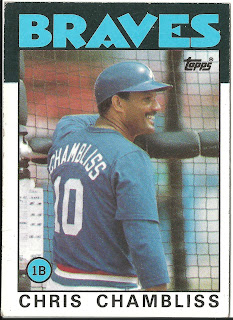Card thoughts: Just hangin', dude. Yukkin' it up with Paul Zuvella.
The
player: Chambliss was considered a clubhouse
leader when he played with the Braves. A good fielder at first despite throwing
right (he batted left), he also had the ability to drive in runs, despite not
being a spectacular power hitter.
As the first pick overall for the lowly Indians in
1970, Chambliss was basically assured a fast track to the majors. He
immediately made an impact in the majors, winning the Rookie of the Year award
the next season over a really weak crop of rookies (second place finisher Bill
Parsons went 13-17 for the Brewers).
The Indians were really terrible in the early 70s,
and Chambliss didn’t really get a chance to show what he could do. His
liberation came with a trade to Yankees, that was really quite a steal for the
Bronx Bombers. In exchange for Chambliss, pitcher Cecil Upshaw (3.02 ERA in
relief in 1974), and Dick Tidrow (11-9 starting in ’74, several good years in
relief after that), the Indians got four pitchers, only Tom Buskey being
effective after the trade.
Chambliss became one of the core players of the
dominant Yankee teams of the mid to late 70s.
From 1976-1978, he drove in over 90 runs each year, with a career high
96 driven in in 1976. That year, he also placed 5th in MVP voting
and made his only all-star game.
Chambliss capped off his best season by giving the Yankees their first
pennant in over 10 years by hitting a walk-off homer
off Royals pitcher Mark Little in the ALCS. This got a little dicey as the fans
mobbed the field, knocking Chambliss over. He probably never touched home
plate.
Chambliss played in the World Series each of his
90-RBI seasons: He hit well in a loss to Cincy in 1976 (.313) and in beating
the Dodgers in 1977 (.792 OPS, 3 extra base hits), but struggled in the 1978
series (.182 slugging percentage).
After a trade after the 1979 season, Chambliss was a
Blue Jay for a month, and then moved on to the Braves. Two players (#45
Damaso Garcia and #119
Barry Bonnell) already covered on this blog were
involved in those transactions. Chambliss was still an effective hitter as grew
older as a Brave. Since he now played his home games at the “Launching Pad”
(Fulton County Stadium), his power improved. Chambliss hit a career high 20
home runs in 1982, and tied that number the next year.
Chambliss’ last year as a regular first baseman was
in 1984 where he hit 9 home runs, drove in 47, and hit .247. With Bob Horner
moving to first base in 1985, he was relegated to the bench. As a pinch hitter
the next two seasons, Chambliss was much more effective in that role in 1986
when he hit .294.
As the hitting coach for the Yankees in 1988, he
came back for one last at bat where he struck out. Chambliss has been either a
coach or manager pretty much since he retired. For a long time, Chambliss’ name
came up every time there was a vacancy, but that has died down in recent years.
Last season, he was the hitting coach for the Mariners.
Chambliss' five hits were four singles and a double. He scored twice: Once on a sacrifice fly by shortstop Jim Mason, and again on a Rick Bladt single. Chambliss drove in three guys with hits: Roy White, Graig Nettles, and Thurman Munson.


1 comment:
He was escorted back to touch the plate later, only to find it gone.
Here's a good first-person account of the play. http://espn.go.com/blog/new-york/yankees/post/_/id/11296/chris-chambliss-remembers-his-walk-off-hr
Post a Comment